Cancer-associated fibroblasts (CAFs) based model reveals potential for predicting bladder cancer patients’ prognoses and immunotherapy responses
Mengyuan Dong, Xu Zhang
1Institute of Biophotonics, South China Normal University, Guangzhou 510631, Guangdong, China.
2Department of Urology, The First Affiliated Hospital of Nanjing Medical University, Nanjing 210029, Jiangsu, China.
Abstract Aim: The purpose of this study is to enhance the understanding of bladder cancer and the role of cancer-associated fibroblasts (CAFs) in its progression.We aim to identify CAF-specific biomarkers and develop a prognostic prediction model based on CAFs, thereby contributing to the advancement of treatment strategies and the identification of prognostic and predictive biomarkers for bladder cancer.
Keywords: Bladder cancer, survival analysis, MAPK signaling cascades, prognosis, biomarkers
INTRODUCTION
Bladder cancer (BC) is the predominant urological cancer in the United States[1].Patients cannot undergo curative surgery after they are diagnosed at an advanced stage[2].Chemotherapy is the primary treatment for the majority of individuals with cancer, involving the administration of various drugs[3].Despite advancements in surgical procedures and healthcare, the outlook for individuals with advanced or resistant to chemotherapy bladder cancer remains unfavorable[4].Until recently, there has been minimal advancement in the management of bladder cancer[5].The same, limited range of treatments have been offered to patients for 30 years, with flat survival rates after five years[6].Checkpoint inhibitors, a novel category of medications, have resulted in the remission of certain individuals with advanced cancers, even when they had a limited life expectancy of just a few months[7].Bladder cancer risk factors can be classified into three subcategories: genetic factors, molecular abnormalities, and exposure to chemicals or the environment.Smoking takes the leading position among the significant factors contributing to chemical and environmental exposures[8].In addition to chronic irritation, the presence of indwelling catheters, and infection caused by Schistosoma haematobium, pelvic radiation can also play a role in BC[9].To effectively and efficiently diagnose and treat BCa, it is crucial to comprehend its progression and discover novel therapies.
It is widely accepted that cells in the tumor microenvironment are accountable for the distinctive characteristics of cancer.Fibroblasts, which are essential in the healing process of wounds and inflammation, also have a significant impact on disease, tissue balance, and the advancement of cancer[10].CAFs, which are myofibroblasts, exert a significant impact on cancer advancement and malignancy, making them the primary stromal element[11].Cancer-associated fibroblasts (CAFs) play a crucial role in the stroma by releasing growth factors, inflammatory molecules, and proteins of the extracellular matrix[12].These substances contribute to the growth of tumors, resistance to therapy, and immune evasion[13].Cancer cells’resistance to primary and secondary drugs is due to their varied, diverse, and flexible nature[14,15].Therapies that focus on the tumor microenvironment (TME) hold potential as cancers progress, infiltrate, and spread under stromal conditions[16].CAFs could potentially be the most crucial element among the diverse constituents comprising the cancer stroma.Regrettably, these cell types are also the most poorly comprehended regarding their origins, subcategories, physiology, and even explanations[17].Gaining a more comprehensive understanding of cancer-associated fibroblasts (CAFs) could prove advantageous for cancer prognosis and treatment[18].Stratifying patients and customizing their treatment could be beneficial in instances where particular CAF groups are linked to distinct cancer subtypes[19].
Initially, we analyze individual cells to uncover biomarkers associated with CAFs.Utilizing single-cell RNA analysis from the TISCH2 database, we identify distinct categories of bladder cancer cells and their associated markers.Subsequently, we employ the ssGSEA method to stratify bladder cancer patients based on fibroblast levels, examining the correlation with clinical features and immune scores.The study then delves into the differential gene expression associated with CAFs, exploring key genes and enriched pathways.Following this, we develop a prognostic prediction model for bladder cancer associated with CAFs, utilizing COX and lasso regression analysis.Finally, the study investigates the relationship between the risk score from the prognostic model, immune-related cells, immune checkpoint-related genes, and the clinical characteristics of bladder cancer patients.This comprehensive approach ensures a thorough examination of CAFs’ role in bladder cancer, aiming to enhance our understanding and treatment of the disease.
METHODS
The dataset downloading of the BC cohort
The Cancer Genome Atlas (TCGA) aims to gather crucial data for cancer researchers, including clinical information on different types of human tumors, genomic alterations, mRNA and miRNA expression,methylation, and other significant data sources.For this study, our primary source of data on bladder cancer patients was the TCGA database, which provided information on mRNA expression levels as well as clinical characteristics associated with the disease.R software was used to analyze the data of BC patients.
The analysis of single-cell RNA sequencing is conducted using the BC samples
The Tumor Immune Single-Cell Hub 2 (TISCH2) is a website dedicated to single-cell analysis, particularly focusing on the tumor immune environment.By offering comprehensive cell type annotations at the individual cell level, it facilitates the investigation of TME in various types of cancer.The TISCH2 dataset was used to obtain the single-cell RNA sequencing data of BC patients in this study.Furthermore, the TISCH2 dataset revealed the identification of bladder cancer fibroblasts.
The ssGSEA algorithm is used for performing gene set enrichment analysis on a single sample
The GSVA v1.30.0 package and method = “ssgsea” were utilized to perform ssGSEA using R v3.5.1.Cell scores were calculated using the signature of our cells associated with the immune system and fibroblasts.An analysis was conducted for every patient with bladder cancer.Subsequently, we assessed the significance of the extended signature for each BC sample.
The analysis of differential expression is conducted using the genes that are crucial
Bladder cancer patients’ RNAseq data (level 3) and their corresponding clinical data can be accessed at The Cancer Genome Atlas (TCGA).The Limma package of R software was utilized to analyze the variation in mRNA expression.
The enrichment analysis of pathways is conducted using the identified key genes
To validate the possible roles of the potential targets, functional enrichment analysis was conducted on the dataset.Gene Ontology (GO) and similar ontologies are extensively employed for gene annotation.Through the examination of the GO functions of prospective mRNAs and the enhancement of KEGG pathways using ClusterProfiler in R, we gained a deeper comprehension of the oncogenic significance of the target genes.
Analysis of infiltration by immune cells
TCGA dataset provided us with clinical information and RNAseq data for bladder cancer.To assess the strength of immune responses, we employed immunedeconv, an R package that integrates six cutting-edge algorithms.After conducting a comprehensive evaluation of these algorithms, it is evident that each algorithm possesses distinct characteristics and advantages.The genes associated with the immune checkpoint were extracted to determine their expression value and level.
Development of the prognostic prediction model using CAFs and its associated genes
Information regarding bladder cancer was obtained from the TCGA dataset library, where the data were downloaded in TPM format and subsequently normalized using log2(TPM+1) transformation.After careful selection, a portion of the samples, which included RNAseq data and clinical information, was ultimately chosen for further analysis.The timeROC analysis was conducted to assess the precision of the prediction model.The R software glmnet package utilizes the LASSO regression algorithm from the Least Absolute Shrinkage and Selection Operator for feature selection, employing 10-fold cross-validation.The analysis above was conducted using the survival package in R software, utilizing multivariate Cox regression analysis.
Gene set enrichment analysis
Sets of genes were obtained from the MSigDB database.The gene sets underwent GSEA using the R package.We selected the most significant 50 terms among the subtypes.
Cell culture
For culturing J82 bladder cancer cell lines, cells were obtained from the Cell Bank of the Chinese Academy of Sciences.Upon receipt, the J82 cell line was cultured in Minimum Essential Medium (MEM)supplemented with 15% fetal bovine serum (FBS, Hyclone, USA).The cells were maintained in a humidified incubator at 37 °C with 5% CO2, ensuring optimal growth conditions.
Construction of short hairpin RNA (shRNA) vectors
To construct shRNA vectors, target gene-specific oligonucleotides were designed and synthesized.These oligonucleotides were annealed and cloned into pLKO.1, which allows for stable integration and expression of the shRNA in mammalian cells.Once the shRNA vectors were constructed, they were transformed into competentE.colicells for amplification and then purified using standard plasmid extraction methods.
qPCR assay
For qPCR analysis, total RNA was extracted from cells using a suitable RNA isolation kit according to the manufacturer’s instructions.The purity and concentration of the RNA were determined using spectrophotometry, ensuring an A260/A280 ratio between 1.8 and 2.0 for high-quality RNA.Complementary DNA (cDNA) was then synthesized from the extracted RNA using a reverse transcription kit, following the manufacturer’s protocol.Subsequently, qPCR was performed using a SYBR Green or TaqMan probe-based qPCR master mix, depending on the specific requirements of the assay.Primers specific to the target gene and GAPDH were designed and validated for efficiency and specificity.The qPCR was carried out in a real-time PCR system, following a standard cycling protocol which typically includes an initial denaturation step, followed by 40 cycles of denaturation, annealing, and extension.
Colony formation assay
To assess the clonogenic ability of cells, a colony formation assay was performed.Initially, cells were trypsinized and counted using a hemocytometer.2,000 cells were then seeded in 6-well culture plates at a low density to allow individual colonies to grow without overlapping.Each well contained the appropriate culture medium for the specific cell type, supplemented with 10% FBS.The plates were then placed in a humidified incubator at 37 °C with 5% CO2.The cells were allowed to grow for a period ranging from 7 to 14 days.
Statical analysis
Statistical significance is determined whenP< 0.05 is calculated using all the aforementioned analytical techniques and R software packages.
RESULTS
The analysis of individual cells uncovers the biomarkers associated with cancer-associated fibroblasts (CAFs) within the bladder cancer cells
We obtained the results of single-cell RNA analysis of bladder cancer cells successfully from the TISCH2.The data was obtained from the GSE130001 repository.Following the analysis of cell subtypes, a grand total of four distinct categories of bladder cancer cells were detected, encompassing endothelial, epithelial,fibroblasts, and myofibroblasts [Figure 1A-C].Following that, the fibroblasts were examined to identify the top ten genes that are highly enriched in them, which serve as markers for the bladder cancer cells’ CAFs.These genes include COL6A2, MMP2, C1S, CTHRC1, DCN, AEBP1, COL6A3, POSTN, RARRES2, and BGN [Figure 1D-M].
The ssGSEA method uncovers the groups of bladder cancer patients with low and high fibroblasts
Using the ssGSEA algorithm, we were able to acquire the scores for immune-associated cells and fibroblasts in every individual with bladder cancer [Figure 2A].Next, the patients with bladder cancer were categorized into groups based on the level of fibroblasts, distinguishing between low and high fibroblasts [Figure 2B].The heatmap indicated that individuals participating in the low-fibroblasts group were also linked to a decreased level of infiltration by immune cells [Figure 2C].Furthermore, bladder cancer patients exhibiting elevated levels of CAFs were strongly correlated with increased stromal score, immune score, and estimate score [Figure 2D] (The Stromal Score indicates the amount of stromal cells in a tumor.Stromal cells are the supportive cells in tissues.In tumors, these cells can affect how the cancer grows and responds to treatments.The score is calculated from gene patterns and helps understand the tumor’s behavior; The Immune Score measures how many immune cells are in a tumor.A high score means more immune cells are present, suggesting a strong immune response against the tumor.This score is useful for figuring out how well the body is fighting the tumor and can influence treatment decisions; The ESTIMATE (Estimation of STromal and Immune cells in MAlignant Tumor tissues using Expression data) Score combines both the Stromal and Immune Scores to show the overall presence of stromal and immune cells in a tumor.A higher score indicates more of these cells.This helps predict how much of the tumor is made up of cancer cells versus supportive and immune cells, which is important for understanding the tumor and planning treatment).Our findings indicate a significant correlation between the Cancer-Associated Fibroblasts(CAFs) scores and numerous genes related to Human Leukocyte Antigens (HLA).Specifically, we observed that bladder cancer patients with higher CAFs scores exhibit altered expression of several HLA genes.This differential expression is noteworthy because HLAs are crucial in the immune system’s ability to recognize and respond to cancer cells.Typically, HLAs present peptides from inside the cell to the immune system; if these peptides are abnormal, as in cancer, they can trigger an immune response.However, in bladder cancer patients with higher CAFs, the altered HLA expression might lead to an impaired presentation of tumor antigens, thereby allowing cancer cells to evade immune detection and destruction.This evasion can contribute to tumor progression and affect patient prognosis.Our results suggest that the interaction between CAFs and HLA expression could be a potential mechanism through which bladder cancer modifies immune surveillance and response [Figure 2E].Furthermore, the analysis of immune cell infiltration indicated a correlation between decreased fibroblasts and increased mast cells and neutrophils [Figure 2F].
The clinical characteristics and genes related to immune checkpoints are associated with the varied scores of CAFs in the bladder cancer cohort
Afterwards, we conducted a correlation analysis between the various groups associated with CAFs and genes related to immune checkpoints.The findings indicated that numerous genes related to immune checkpoints are linked to CAF scores [Figure 3A and B].The correlation analysis indicated that higher expression levels of immune-related genes are linked to higher scores of CAFs for the majority of immune checkpoint-related genes.This implies that bladder cancer patients belonging to the higher CAFs groups might have improved responsiveness to immune checkpoint therapy.Furthermore, the correlation analysis also revealed that numerous clinical features are linked to the CAFs scores.The CAFs scores are lower in older bladder cancer patients.Men with bladder cancer are at a higher risk of being associated with low-CAFs groups.Furthermore, bladder cancer patients in the low-CAFs groups exhibit a lower grade, and those in the low-CAFs groups show a lower TNM stage [Figure 3C-H].
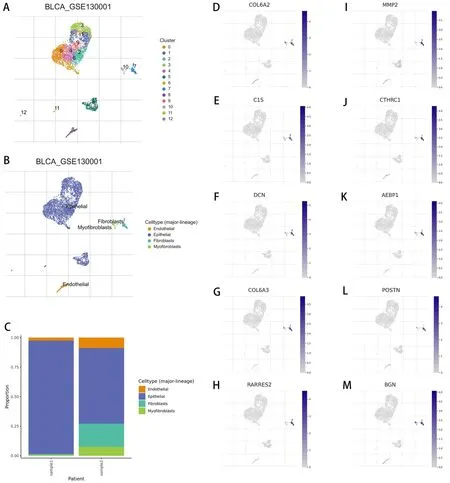
Figure 1.(A and B) The single-cell RNA sequencing analysis demonstrated the cell grouping in bladder cancer cohort; (C) The cell proportions of single-cell RNA sequencing in bladder cancer samples; (D-M) The single-cell RNA sequencing demonstrated that COL6A2, MMP2, C1S, CTHRC1, DCN, AEBP1, COL6A3, POSTN, RARRES2 and BGN could be regarded as the potential markers for fibroblasts.
Identification of the primary genes linked to the CAFs and pathways
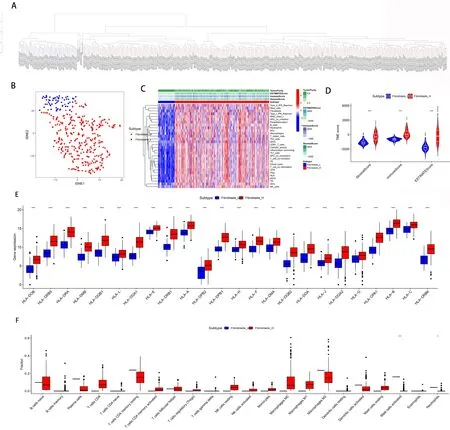
Figure 2.(A and B) The ssGSEA algorithm was used to divide the bladder cancer patients into low- and high-CAFs groups; (C) The heatmap demonstrated the different distribution of immune-related cells and fibroblasts in bladder cancer cohort; (D) The different immune-related scores between low- and high-CAFs groups; (E) The different expression levels of HLA-related genes between lowand high-CAFs groups; (F) The different expression level of immune-related cells between low- and high-CAFs groups.★represents a statistical significance level where P ≤ 0.05.★★represents a statistical significance level where P ≤ 0.01.★★★represents a statistical significance level where P ≤ 0.001.ns represents no statistical significance.
Next, to investigate the key genes linked to the CAFs, we conducted an analysis of differential gene expression between the low-CAFs and high-CAFs groups.The findings indicated that a sum of 2,712 genes were identified as the genes with differential expression, comprising 553 genes that were down-regulated and 2,159 genes that were up-regulated [Figure 4A and B].Afterwards, we assessed the enrichment analysis of GO and KEGG using the crucial genes.According to the KEGG enrichment analysis, the pathways with the highest enrichment are chemokine signaling pathway, and hematopoietic cell lineage [Figure 4C and D].The GO enrichment analysis revealed that the most enriched pathways in GO BP include cell activation, cell migration, biological adhesion, and positive regulation of the immune system process [Figure 4E].The results of the GO CC enrichment analysis showed a strong association between the key genes and various components, including the intrinsic part of the plasma membrane, the cell surface, external encapsulating structures, the membrane side, and the extracellular matrix containing collagen [Figure 4F].The enrichment analysis of GO MF revealed that the pathways with the highest enrichment are molecular transducer activity, antigen binding, extracellular matrix structural constituent, and heparin binding[Figure 4G].
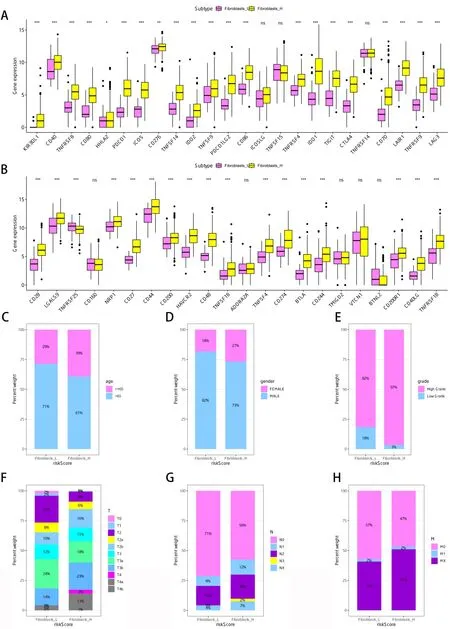
Figure 3.(A and B) The different expression levels of immune checkpoint-related genes between low- and high-CAFs groups; (C-H)The correlation analysis between CAFs-related score and clinical-related characteristics in bladder cancer cohort.★represents a statistical significance level where P ≤ 0.05.★★represents a statistical significance level where P ≤ 0.01.★★★represents a statistical significance level where P ≤ 0.001.ns represents no statistical significance.
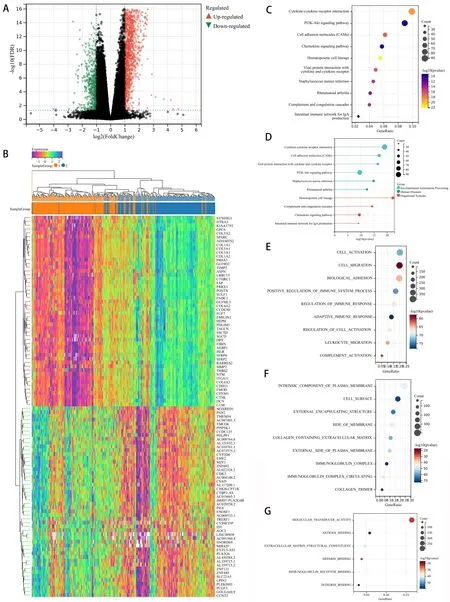
Figure 4.(A) The volcano map demonstrated the differential expressed genes between low- and high-CAFs groups; (B) The heat map demonstrated the differential expressed genes between low- and high-CAFs groups; (C and D) The KEGG enrichment analysis; (E) The GO BP enrichment analysis; (F) The GO CC enrichment analysis; (G) The GO MF enrichment analysis.
Development of the prognostic prediction model for bladder cancer cohort associated with CAFs construction
To further investigate genes primarily linked to CAFs, we conducted COX regression and lasso regression analysis to develop a prognostic prediction model for CAFs.The prognosis is associated with a total of 16 genes, as shown by the Univariate COX regression analysis.To construct the prognostic prediction model related to CAFs [Figure 5A], further analysis using lasso regression and multivariate Cox regression was conducted [Figure 5B].A risk score was assigned to every patient with bladder cancer.The risk score is calculated by multiplying the values of ALDH1L2, AL450384.2, EMP1, LINC02362, WFIKKN1, GOLGA8A,POU5F1, AL354919.2, and PTPRR with their respective coefficients and summing them up.Subsequently,the bladder cancer patients were categorized into low- and high-risk groups in both the training and test groups [Figure 5E and F].The survival analysis showed that bladder cancer patients in the high-risk group had a lower OS in both the training and test groups [Figure 5C and D].Furthermore, the time-sensitive ROC curve revealed that the prognostic prediction model associated with CAFs exhibited excellent predictive efficacy in both the training and test cohorts [Figure 5G and H].
The correlation analysis between the risk score and immune-related cells, as well as immune checkpoint-related genes
The findings indicated that numerous cells related to the immune system were strongly linked to the risk score.The risk scores show a positive correlation with fibroblasts, M0 macrophages, M1 macrophages, and M2 macrophages, but a negative association with CD8+ T cells and regulatory T cells [Figure 6A-G].Next,we conducted a correlation analysis to examine the relationship between risk scores and genes associated with immune checkpoints.The findings indicated that bladder cancer patients in high-risk categories exhibit elevated levels of ICOSLG, TNFRSF9, ADORA2A, CD274, and CD244 expression [Figure 6H and I].Furthermore, we conducted an independent prognostic analysis using both the risk score and clinical characteristics, considering both univariate and multivariate factors.The analysis of prognostic factors for bladder cancer patients revealed that age, stage, T stage, M stage, N stage, and risk score are independent prognostic variables in univariate analysis [Figure 6J].The analysis of multiple independent prognostic factors showed that age, T stage, N stage, and risk score are significant factors for predicting the prognosis of patients with bladder cancer [Figure 6K].
Exploring the relationship between risk score and clinical characteristics, as well as investigating the potential pathways linked to the risk score
We assess the possible connections between clinical-related attributes and the risk score.The findings indicated a strong correlation between the risk score and the grade, stage, T stage, and M stage of individuals diagnosed with bladder cancer.Bladder cancer patients who have a greater risk score are linked to a higher grade, stage, T stage, and M stage [Figure 7A-H].Subsequently, to investigate the possible connections between risk score and potential pathways, we conducted the GSVA enrichment analysis.The risk score for KEGG terms is strongly linked to the wnt, toll-like receptor, TGF beta, MAPK, and mTOR signaling pathway [Figure 7I].The most enriched pathways were TNFA signaling via NFKB, and allograft rejection, according to HALLMARK terms [Figure 7J].
Suppression of EMP1 expression by shRNA affects clonogenic capacity in J82 bladder cancer cells
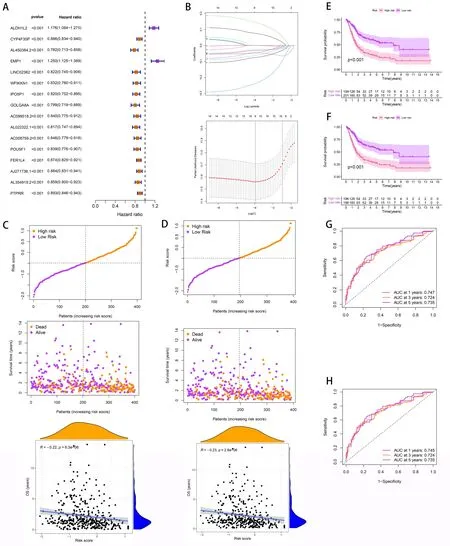
Figure 5.(A) The univariate COX regression was applied to explore the prognosis-related genes; (B) The lasso regression analysis was further used to explore the prognosis-related genes; (C) The survival analysis in the training cohort; (D) The survival analysis in the testing cohort; (E) The risk curves in the training cohort; (F) The risk curves in the testing cohort; (G) The ROC curve in the training cohort; (H) The ROC curve in the testing cohort.
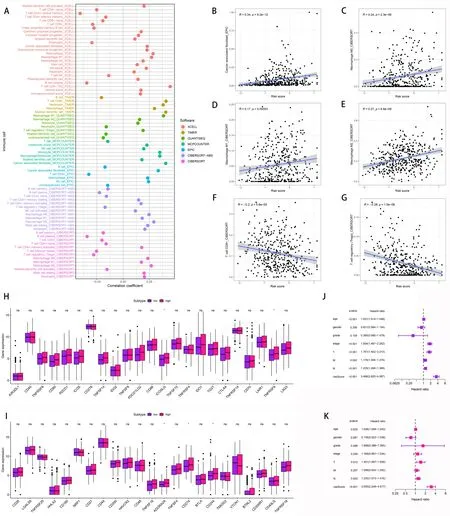
Figure 6.(A-G) The correlation analysis between risk score and immune-related genes; (H and I) The correlation analysis between risk score and immune checkpoint-related genes; (J) The univariate independent prognostic analysis; (K) multivariate independent prognostic analysis.★represents a statistical significance level where P ≤ 0.05.ns represents no statistical significance.
In J82 bladder cancer cells, the knockdown of EMP1 expression was achieved through shRNA-mediated silencing.The efficiency of EMP1 suppression was confirmed via real-time quantitative polymerase chain reaction (RT-qPCR), with results indicating a significant reduction in EMP1 mRNA levels in cells treated with sh-EMP1 compared to the negative control (NC) [Figure 8A].Subsequent phenotypic assessment through colony formation assays revealed a notable increase in clonogenic potential upon EMP1 knockdown.The number of colonies formed by sh-EMP1 treated J82 cells was markedly higher than those observed in the NC group, demonstrating a substantial impairment in the ability of cells to proliferate and form colonies over the assay period [Figure 8B].
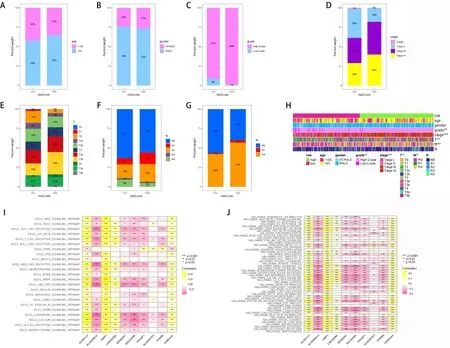
Figure 7.(A-H) The correlation analysis between risk score and clinical-related characteristics; (I) The GSVA analysis based on the KEGG terms; (J) The GSVA analysis based on the HALLMARK terms.
DISCUSSION
BC, the most prevalent urological cancer, had approximately 81,400 newly diagnosed cases in 2019[20].Despite advancements in surgical procedures and medication treatments for individuals with advanced or resistant bladder cancer, the outlook continues to be bleak[21].CAFs greatly promote cancer malignancy and progression, making myofibroblasts the crucial stromal element.Primary and secondary drug resistance can occur due to the variety, variation, and flexibility of cancer cells[22].The influence of stromal conditions on cancer growth, invasion, and metastasis is well-documented, indicating that treatments focused on CAFs have the potential to be successful.Hence, we investigate the possible connections between CAFs and bladder cancer in order to identify biomarkers and therapies based on CAFs.Initially, the analysis of scRNA sequencing furnished us with the indicators of fibroblasts within the cells of bladder cancer.The patients with bladder cancer were effectively classified into groups with low-CAFs and high-CAFs.Moreover, we identified the strong connections between CAFs-associated score and immune cells, as well as genes related to immune checkpoints.The correlation analysis indicated that a greater expression level of genes related to the immune system is linked to higher scores of CAFs.This implies that bladder cancer patients belonging to the higher CAFs groups might have a higher likelihood of benefiting from immune checkpoint therapy.It has recently been discovered that CAF and TME interact to promote tumor progression.The majority of immune cells in the tumor microenvironment (TME) are located within tumor islets, exhibiting a strong association with the immune response against the tumor.CAFs secrete a range of cytokines, growth factors,chemokines, exosomes, and other molecules to respond to immune cells infiltrating the tumor, along with other immune elements present in the TME[23].Consequently, cancerous cells possess the capability to elude the immune system due to the immunosuppressive tumor microenvironment[24].Examining the intricate relationship between CAFs and immune cells could potentially lead to the development of novel targeted immunotherapy approaches.This study may offer fresh perspectives on immunotherapy for patients with bladder cancer by establishing a connection between CAFs and bladder cancer, as well as exploring immune-related indicators.

Figure 8.(A) EMP1 mRNA Expression Post-shRNA Transduction.Bar graph representing the relative expression levels of EMP1 mRNA in J82 bladder cancer cells.Cells transduced with shRNA targeting EMP1 (sh-EMP1) exhibit a significant decrease in EMP1 mRNA levels compared to the negative control (NC) group, indicating effective knockdown; (B) Colony Formation Assay Post-EMP1 Knockdown.Representative images of colony formation assays in 6-well plates.J82 cells treated with sh-EMP1 show an increased number of colonies compared to the NC, suggesting an enhanced clonogenic potential upon EMP1 suppression.
Additionally, we conducted a prognostic prediction analysis using the key genes associated with the bladder cancer cohort.By conducting the COX regression, we have effectively developed the CAFs-related model.Bladder cancer patients’ prognosis was closely linked to a total of 9 genes.Previous research studies have identified numerous genes associated with cancer-associated fibroblasts (CAFs) that could serve as potential biomarkers for individuals with cancer.Previous studies have identified specific ECM genes (C-ECM) that are overexpressed in tumors and linked to worse prognoses[25].Immunosuppression was observed in cancerassociated fibroblasts due to dysregulation of the C-ECM transcriptional program.In this study, we also found that the CAFs-related prognostic prediction model is associated with numerous enriched pathways,including the mTOR signaling pathway.Previous research has revealed that the mTOR signaling pathway plays a crucial role in individuals diagnosed with bladder cancer[26].Combining ferroptosis inducers and mTOR inhibitors[27]can enhance the treatment options for bladder cancer, as revealed by a study.Targeting ADAMTS9-AS1 for bladder cancer treatment may activate the PI3K/AKT/mTOR signaling pathway, as indicated by another recent study[28].
While this study provides valuable insights into the role of cancer-associated fibroblasts (CAFs) in bladder cancer, it is important to acknowledge its limitations[29-31].First, the reliance on single-cell RNA analysis from the TISCH2 database, while innovative, may limit the understanding of CAFs’ functional heterogeneity and dynamic behavior in different tumor microenvironments.Second, the categorization of bladder cancer patients based on fibroblast levels, though informative, does not account for the full complexity of individual patient variability and treatment history.Additionally, while the development of the prognostic prediction model represents a significant step forward, its predictive power and clinical utility need validation in prospective studies and diverse patient cohorts.Lastly, the study’s findings are primarily based on retrospective data, which might not fully capture the nuances of CAFs’ interactions in live, evolving tumors or under different treatment regimens.Recognizing these limitations is crucial for interpreting the results and for guiding future research directions to build upon this work.
Conclusion
Overall, our investigation indicates that the CAFs have a strong correlation with the outlook and effectiveness of immunotherapy in individuals diagnosed with bladder cancer.Furthermore, the risk assessment model relying on the CAFs is strongly linked to the outlook of individuals diagnosed with bladder cancer.
DECLARATIONS
Authors’ contributions
Designed the study: Zhang X, Dong M
Coordinated the project: Dong M
Both authors confirmed the authorship and approved the final manuscript.
Availability of data and materials
The data and materials are available upon request from the correspondence author.
Financial support and sponsorship
None.
Conflicts of interest
Both authors declared that there are no conflicts of interest.
Ethical approval and consent to participate
For this research, the primary data source was the TCGA database.We examined RNA sequences of individual cells to identify markers for cancer-associated fibroblasts (CAFs) in bladder cancer cells.Since the data was obtained from an existing public database, our research did not require ethical approval.
Consent for publication
As the data on bladder cancer patients was sourced from the TCGA database, a publicly available resource,obtaining consent from the patients was not necessary for this study.
Copyright
? The Author(s) 2024.
 Journal of Cancer Metastasis and Treatment2024年2期
Journal of Cancer Metastasis and Treatment2024年2期
- Journal of Cancer Metastasis and Treatment的其它文章
- Editorial on “Chinese expert consensus on the clinical practice of non-small cell lung cancer fusion gene detection based on RNA-based NGS” (2023 edition)
- Integration of community pharmacies in an Italian colorectal cancer screening program: insights from the Local Health Authority of Bologna
- Consideration of liquid biomarkers for surveillance of HPV-related oropharyngeal cancer in veteran populations
